July 22 to July 28
The Love River’s (愛河) four-decade run as the host of Kaohsiung’s annual dragon boat races came to an abrupt end in 1971 — the once pristine waterway had become too polluted. The 1970 event was infamous for the putrid stench permeating the air, exacerbated by contestants splashing water and sludge onto the shore and even the onlookers.
The relocation of the festivities officially marked the “death” of the river, whose condition had rapidly deteriorated during the previous decade. The myriad factories upstream were only partly to blame; as Kaohsiung’s population boomed in the 1960s, all household wastewater went directly into the waterway due to poor sewage management.

Photo courtesy of Wikimedia Commons
The government finally began rectifying the problem in 1977. The first phase, which entailed installing mechanisms to intercept wastewater and building separate sewers, took 10 years to complete. In February 1987, Kaohsiung city councilor Chen Tsun-hsiung (陳村雄) jumped into the river during a press conference. After emerging, he told reporters that the water was “sweet,” and after he got home he reportedly found a small crab in his suit pocket.
The dragon boat races returned to the Love River that year, but there was still a lot of work to do. It wasn’t until July 24, 2002 that the government considered the project a success, celebrating by reopening the gate separating the upper and lower parts of the rivers that had been shut off for 16 years. By this time, the Love River had once again become a popular hangout spot, with cruises, riverside parks, coffee shops and other sights.
News reports of dirty water would continue to surface in the ensuing decades, and the government still had to fix the river’s upper reaches — but the worst was over.
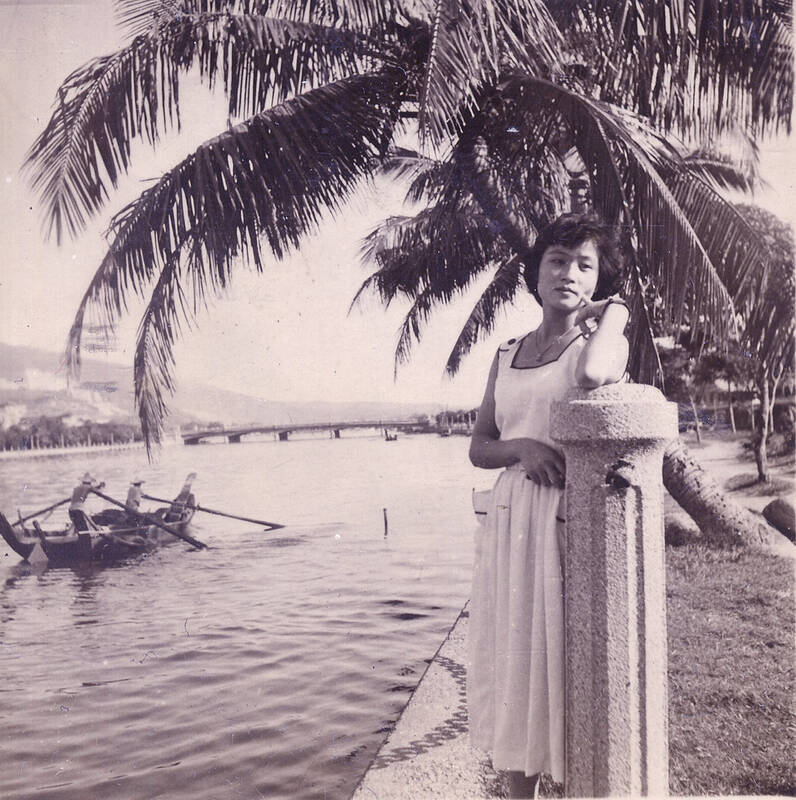
Photo courtesy of Kaohsiung City Bureau of Cultural Affairs
RIVER OF LOVE?
For those familiar with local toponymy, “Love River” is an unusual name for a Taiwanese waterway. In fact, it was originally called the Takao River, and later the Kaohsiung River, obtaining its current name by pure accident. Most accounts state that there was a tourist operation along the river named the Love River Cruise (愛河遊船所) during the late 1940s. In 1947, a typhoon blew off the “cruises” part of the sign, and it was never repaired.
The following June, a woman’s corpse was found in the river. It was suspected that she committed suicide due to love problems, as it was common method in those days for forbidden lovers to die (there was even a movie in 1956 about it called The Canal Suicides, 運河殉情記). A reporter who had recently moved to Kaohsiung saw the sign and wrote it into the story’s headline — and somehow, the name stuck. By July 1950, most media outlets, including the state-run Central Daily News (中央日報), were referring to it as “Love River.”
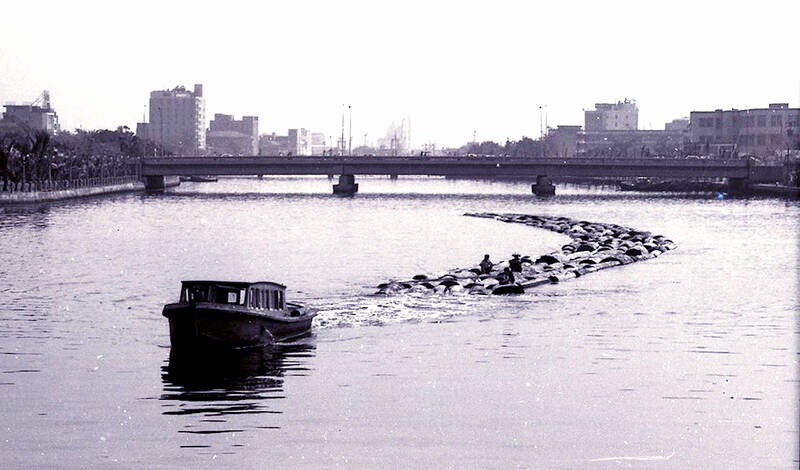
Photo courtesy of Kaohsiung City Bureau of Cultural Affairs
It was renamed Renai River (仁愛河) in 1970, a name that the ruling Chinese Nationalist Party (KMT) favored and gave to numerous locales, but locals continued to use the old name. In 1992, five years after the lifting of martial law, it was once again renamed the Love River.
PUTRID STENCH
Until the 1960s, the river was a pleasant spot for people to relax on the banks or enjoy a boat ride, and commercial activity was also abuzz. But the city was growing fast — from 168,008 people in 1947 to 669,146 in 1967 — as it developed into an industrial behemoth. A large percentage was concentrated along the river.
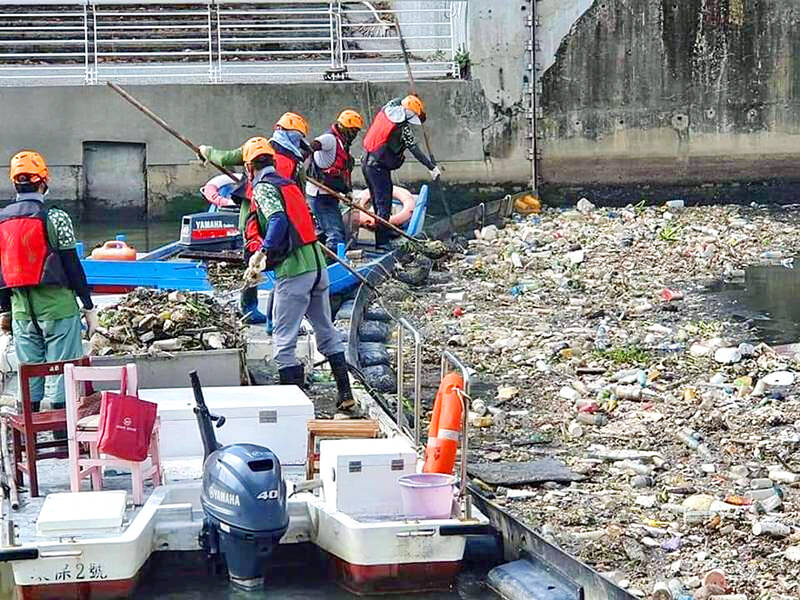
Photo courtesy of Kaohsiung City Government
After the government in 1947 banned logging in Alishan, timber companies began importing wood from Southeast Asia. Since the goods arrived in Kaohsiung harbor, these businesses built log ponds and processing facilities along the Love River. It was a common sight to see small motorboats dragging hundreds of logs, and this was the beginning of the river’s contamination.
Later, other factories (mostly leather, food processing, paper and chemical) sprung up along the waterway further inland in Gushan (鼓山) and Sanmin (三民) districts.
During the 1930s, the city’s famous dragon boat races, which were originally held by the ocean, were moved to the Love River. According to a China Times (中國時報) article, a particularly spirited team comprised of Marines splattered foul water and mud onto horrified audience members during their performance in 1970, and that was the last straw.
The next year, the races were moved to Lotus Lake (蓮池潭) and the river was declared dead, as only the hardiest creatures could survive in such waters. The China Times article states that back then, whenever passing by the river people could only cover their noses and quicken their pace.
RESUSCITATING THE RIVER
Hu Chin-yin (胡金印) writes in “Shaping the landscape for urban riverside tourism — Kaohsiung’s Love River as an example” (都市河岸觀光景觀之形塑—以高雄市愛河為例) that the first phase of the cleaning process involved setting up 11 wastewater interception stations along the river, especially in the heavily populated lower reaches, beautifying the banks and removing long standing illegal structures, and dredging 380,000m2 of sludge.
By the time Chen jumped into the Love River, there was still no separation of domestic and storm sewage, meaning that wastewater still went directly into the waterway before it was intercepted and diverted to a treatment plant.
The part that Chen submerged himself in was indeed cleaner at that time, but the waters upstream were still quite polluted. During heavy rain, the intercepting gates were opened and the filth still flooded into the downtown section.
The second phase was to upgrade wastewater interception and treatment capabilities, and to continue building and repairing sewage pipes while connecting households to the system. Hu writes that by 1997, 11 percent of the wastewater producing area was directly connected. This number reached 50.1 in 2007.
In 2001, Kaohsiung hosted the Taiwan Lantern Festival, which had been held in Taipei since its inception in 1990. The centerpiece was the “Jumping Turtle, Soaring Dragon” (鰲躍龍翔) installation by the Love River, which remains a landmark today.
The festival was held by the Love River again the following year, and an annual local version has taken place by the riverbank since. Cruises had resumed, and the Love River was once again teeming with activity.
Taiwan in Time, a column about Taiwan’s history that is published every Sunday, spotlights important or interesting events around the nation that either have anniversaries this week or are tied to current events.

That US assistance was a model for Taiwan’s spectacular development success was early recognized by policymakers and analysts. In a report to the US Congress for the fiscal year 1962, former President John F. Kennedy noted Taiwan’s “rapid economic growth,” was “producing a substantial net gain in living.” Kennedy had a stake in Taiwan’s achievements and the US’ official development assistance (ODA) in general: In September 1961, his entreaty to make the 1960s a “decade of development,” and an accompanying proposal for dedicated legislation to this end, had been formalized by congressional passage of the Foreign Assistance Act. Two

March 31 to April 6 On May 13, 1950, National Taiwan University Hospital otolaryngologist Su You-peng (蘇友鵬) was summoned to the director’s office. He thought someone had complained about him practicing the violin at night, but when he entered the room, he knew something was terribly wrong. He saw several burly men who appeared to be government secret agents, and three other resident doctors: internist Hsu Chiang (許強), dermatologist Hu Pao-chen (胡寶珍) and ophthalmologist Hu Hsin-lin (胡鑫麟). They were handcuffed, herded onto two jeeps and taken to the Secrecy Bureau (保密局) for questioning. Su was still in his doctor’s robes at
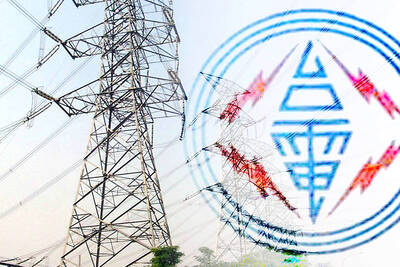
Last week the Democratic Progressive Party (DPP) said that the budget cuts voted for by the China-aligned parties in the legislature, are intended to force the DPP to hike electricity rates. The public would then blame it for the rate hike. It’s fairly clear that the first part of that is correct. Slashing the budget of state-run Taiwan Power Co (Taipower, 台電) is a move intended to cause discontent with the DPP when electricity rates go up. Taipower’s debt, NT$422.9 billion (US$12.78 billion), is one of the numerous permanent crises created by the nation’s construction-industrial state and the developmentalist mentality it
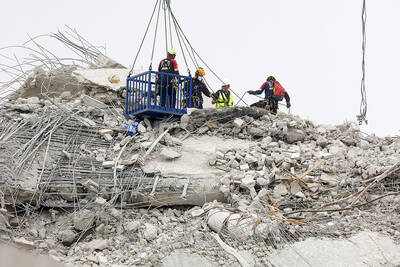
Experts say that the devastating earthquake in Myanmar on Friday was likely the strongest to hit the country in decades, with disaster modeling suggesting thousands could be dead. Automatic assessments from the US Geological Survey (USGS) said the shallow 7.7-magnitude quake northwest of the central Myanmar city of Sagaing triggered a red alert for shaking-related fatalities and economic losses. “High casualties and extensive damage are probable and the disaster is likely widespread,” it said, locating the epicentre near the central Myanmar city of Mandalay, home to more than a million people. Myanmar’s ruling junta said on Saturday morning that the number killed had